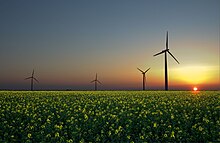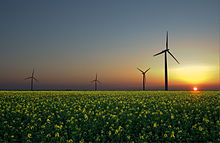 Renewable energy
Renewable energy
Renewable energy is energy that comes from resources which are continually replenished such as sunlight, wind, rain, tides, waves and geothermal heat. About 16% of global final energy consumption comes from renewable resources, with 10%[discuss] of all energy from traditional biomass, mainly used for heating, and 3.4% from hydroelectricity. New renewables (small hydro, modern biomass, wind, solar, geothermal, and biofuels) accounted for another 3% and are growing very rapidly.The share of renewables in electricity generation is around 19%, with 16% of electricity coming from hydroelectricity and 3% from new renewables.
Wind power is growing at the rate of 30% annually, with a worldwide installed capacity of 282,482 megawatts (MW) at the end of 2012, and is widely used in Europe, Asia, and theUnited States. At the end of 2012 the photovoltaic (PV) capacity worldwide was 100,000 MW, and PV power stations are popular in Germany and Italy. Solar thermal power stations operate in the USA and Spain, and the largest of these is the 354 MW SEGS power plant in the Mojave Desert. The world’s largest geothermal power installation is The Geysers in California, with a rated capacity of 750 MW. Brazil has one of the largest renewable energy programs in the world, involving production of ethanol fuel from sugar cane, and ethanol now provides 18% of the country’s automotive fuel. Ethanol fuel is also widely available in the USA.
There is an ongoing renewable energy debate, the debate on biofuels include the food vs fueldilemma and the Indirect land use change impacts of biofuels. The debate on hydropowerinstallations usually revolve around the footprint of dam floodplains, with for example theThree Gorges dam, the largest renewable electricity source in the world, having displaced 1.3 million people, and garnered environmental criticism.The debate on new renewables, such as wind and solar, is usually much less intense, and focuses on theirintermittent supply of electricity, higher cost of electricity, and a small but growing community opposition to the industrialized footprint of large solar and wind farm installations. Renewable energy accidents with large losses of life include the Banqiao dam failure and the inhalation of particulate matter from the burning of biomass.
While many renewable energy projects are large-scale, renewable technologies are also suited to rural and remote areas, where energy is often crucial in human development.[8] As of 2011, small solar PV systems provide electricity to a few million households, and micro-hydro configured into mini-grids serves many more. Over 44 million households use biogasmade in household-scale digesters for lighting and/or cooking, and more than 166 million households rely on a new generation of more-efficient biomass cookstoves. United Nations‘ Secretary-General Ban Ki-moon has said that renewable energy has the ability to lift the poorest nations to new levels of prosperity.
Climate change and global warming concerns, coupled with high oil prices, peak oil, and increasing government support, are driving increasing renewable energy legislation, incentives and commercialization. New government spending, regulation and policies helped the industry weather the global financial crisis better than many other sectors.According to a 2011 projection by the International Energy Agency, solar power generators may produce most of the world’s electricity within 50 years, dramatically reducing the emissions of greenhouse gases that harm the environment.
Renewable energy sources, that derive their energy from the sun, either directly or indirectly, such as Hydro and wind, are expected to be capable of supplying humanity energy for almost another 1 billion years, at which point the predicted increase in heat from the sun is expected to make the surface of the Earth too hot for liquid water to exist.
